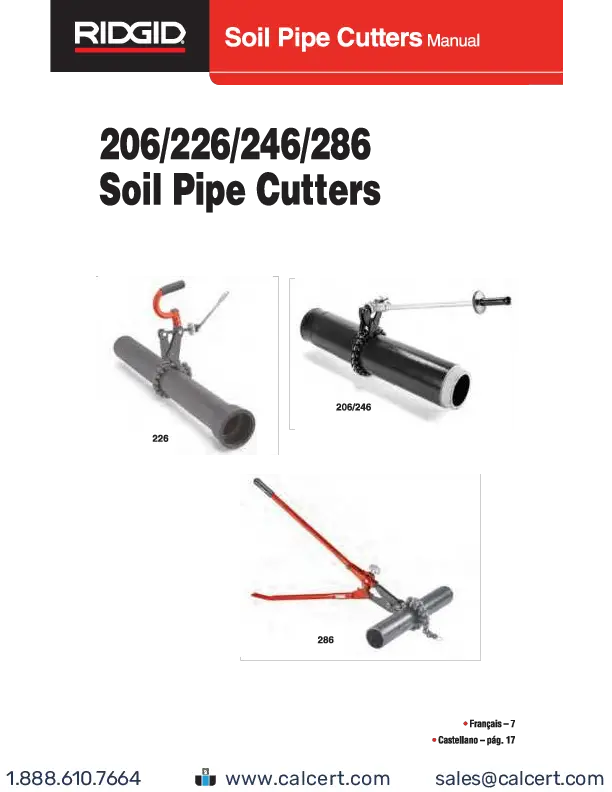RIDGID Pipe Stand User Guide
This guide provides essential information on the safe operation, inspection, maintenance, and setup of RIDGID Pipe Stands.
Important Safety Information
WARNING: Read all warnings and instructions for all equipment being used before operating this tool to reduce the risk of serious personal injury.
SAVE THESE INSTRUCTIONS!
- Properly support pipe and stay clear of supported loads. Failure to do so can cause stand tipping, falling pipe, and serious injury.
- Do not exceed stand ratings (marked on product). Exceeding ratings can damage the stand and increase injury risk.
- Inspect the stand before each use to reduce the risk of tipping, falling pipe, and serious injury.
- Keep hands clear of pinch points to prevent pinching and crushing injuries.
- Use appropriate safety equipment: Always wear proper eye and foot protection. Dust mask, face shield, or hearing protection may be needed.
- Do not raise the elevator tube above the hand screw. This can cause stand tipping, falling pipe, and serious injury. Ensure the lock ring securely engages the elevator tube and tighten the hand screw firmly.
Description
RIDGID Pipe Stands are designed to support pipes for a variety of uses. Refer to the product label or the RIDGID catalog for specific model specifications.
Figure 1: RIDGID Pipe Stands Overview
Figure 1 illustrates various RIDGID pipe stand models, showcasing their designs and key components. The models shown include VJ-99, RJ-99, CJ-99, VF-99, models 46, 92, 965, AR-99, and RJ-624. These stands generally consist of a stable base (often tripod-style), an adjustable vertical tube known as the elevator tube, and a head assembly at the top for pipe support. Height adjustment mechanisms vary by model, including hand screws with lock rings, adjusting collars, or jack screws for fine adjustments. Some models are equipped with rollers to facilitate pipe movement.
Key Components Identified:
- Head Assembly: The top section that contacts and supports the pipe. It may feature V-grooves, rollers, or be designed for ball transfer heads.
- Elevator Tube: The vertical tube that moves up and down to adjust the stand's working height.
- Jack Screw Handle / Hand Screw: The mechanism used to adjust the height of the elevator tube.
- Lock Ring / Adjusting Collar: Devices used to secure the elevator tube at the desired height.
- Base: The supporting structure, typically a tripod, ensuring stability.
- Roller: An optional feature on some stands that allows pipes to be moved smoothly across the stand.
Inspection and Maintenance
Regular inspection and maintenance are crucial for safe and reliable operation. Follow these steps:
- Clean the stand to aid inspection and improve handling.
- Before each use, inspect the stand for proper assembly, wear, damage, or modifications that could affect safe use.
- Look for bent components or damaged welds.
- Install any required parts, such as the hand screw.
- If any problems are found, do not use the stand until they are corrected.
- Lubricate all moving parts and joints as needed with light lubricating oil. Wipe up any excess oil.
Set Up and Operation
- Ensure all equipment is inspected and set up according to its specific instructions.
- Locate a clear, level, and stable area for the stand, other equipment, and the operator.
- For folding stands, make sure the legs are fully open and the feet sit squarely on the level floor.
- If the stand is equipped with rollers, adjust them properly for the pipe size. Ball transfer heads can be used with VJ and VF stands. Ensure all fasteners are secure.
- Height Adjustment:
- Do not exceed the stand's rated capacity.
- VJ, CJ, RJ, VF Stands (with Lock Ring): Securely grip the head assembly. Loosen the hand screw. Raise the lock ring to disengage the elevator tube. Move the head assembly to the desired height and lower the lock ring to engage the elevator tube. Do not raise the elevator tube above the hand screw. Ensure the lock ring securely engages the elevator tube and tighten the hand screw firmly against it.
- 92 and 46 Stands (with Adjusting Collar): Securely grip the head assembly. Raise the adjusting collar to allow the elevator tube to move. Move the head assembly to the desired height and lower the collar to hold the elevator tube in place. Ensure the elevator tube is secure.
- Models with Jack Screw (for fine adjustment): Hold the head assembly stationary and turn the jack screw handle to position as desired. Do not force the jack screw handle or use handle extensions, as this can damage the jack screw and cause it to come out of the base.
- Position the stands to properly support the pipe. Generally, pipe should be supported at a minimum of two points. The number and placement of stands depend on specific circumstances, including pipe size, length, and weight.
- Carefully place the pipe onto the stands. Ensure the pipe is properly centered on the stands to reduce the risk of tipping. Do not drop the pipe onto the stands. Do not exceed the stand ratings. Make sure the pipe is stable and secure. Always stay clear of supported loads. Do not move a stand while it is loaded.
Contact Information
If you have any questions concerning this RIDGID product:
- Contact your local RIDGID distributor.
- Visit RIDGID.com to find your local RIDGID contact point.
- Contact the Ridge Tool Technical Service Department at ProToolsTechService@emerson.com, or in the U.S. and Canada call 844-789-8665.








